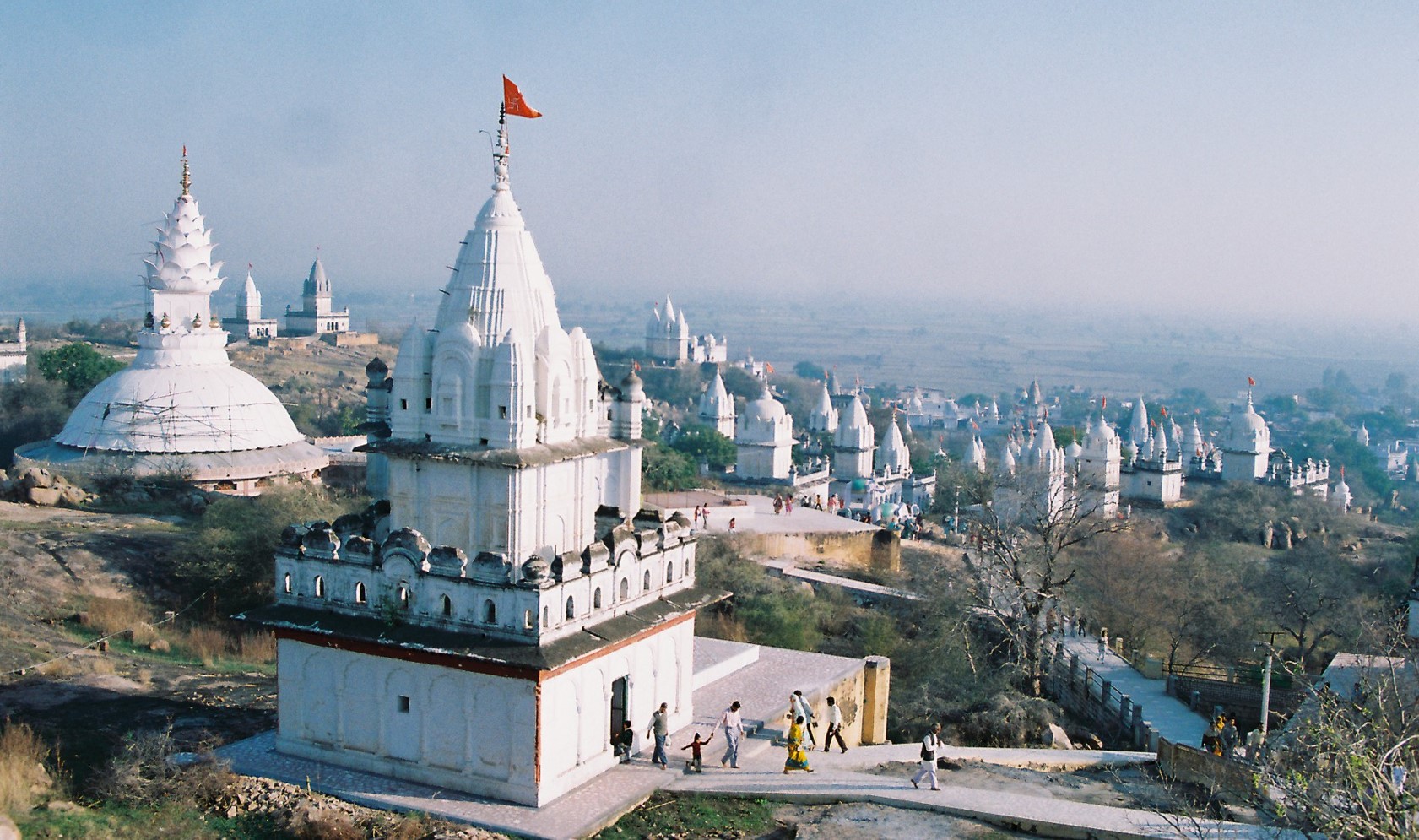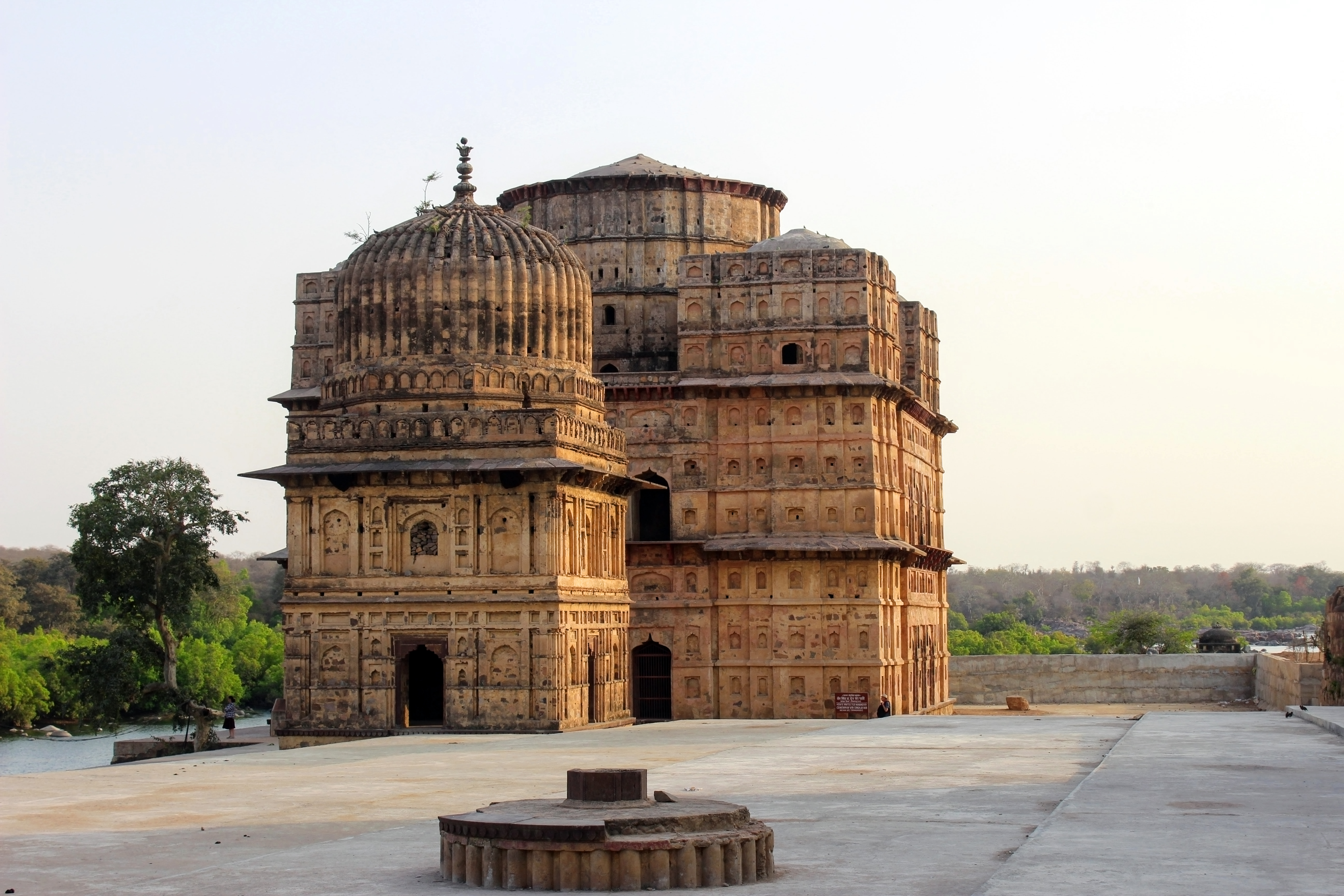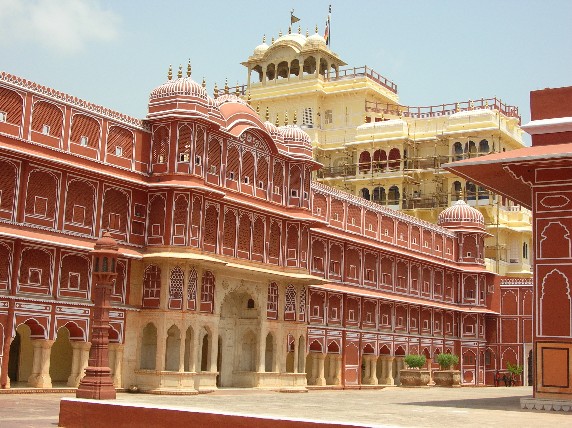|
Datia Palace
Datia Palace, also known as Bir Singh Palace or Bir Singh Dev Palace, is situated nearly 75 km from Gwalior city in Madhya pradesh. The specialty of the palace is that it has 7 floors and no member of the royal family lived in the palace. The founder of the Datia State in Bundelkhand - Maharaj Birsingh Deo Build many such 52 monuments all around the country. Datia Palace is also known as Satkhanda Palace, Datia Mahal, and Purana Mahal or the "Old Palace". Historian Abdul Hamid Lahori came to this city with Shah Jahan on 19 November 1635. He said that the palace was nearly 80 meters long and was also this much broad. He said this as a very beautiful and strong palace. This Palace was made by spending 35 Lakh Rupees (78 thousand US dollars), and it took nine years to build it. It is situated on an isolated rock on the western side of the city Datia. It represents Mughal architecture along with Rajput architecture. It is the biggest and most famous of all the 52 palaces build ... [...More Info...] [...Related Items...] OR: [Wikipedia] [Google] [Baidu] |
Datia
Datia is the district headquarter of the Datia District in north central Madhya Pradesh,a state of Central India. It is an ancient town, mentioned in the Mahabharata ruled by King Dantavakra. The city is 78 km from Gwalior, 325 km south of New Delhi and 344 km north of Bhopal. About 18 km from Datia is Sonagiri, a sacred Jain hill. Datia is also about 31 km from Jhansi and 52 km from Orchha. The nearest airport is at Gwalior. It was formerly the seat of the eponymous princely state in the British Raj. Datia is situated near Gwalior and on the border with Uttar Pradesh. The old town is surrounded by a stone wall, encompassing beautiful palaces and gardens. The 17th-century palace of Vir Singh Deo is a notable example of the Hindu architecture of North India. The town serves as a trading center for grains and cotton products. Handloom weaving is an important industry. Datia has several important landmarks and is famous for the seven-story up an ... [...More Info...] [...Related Items...] OR: [Wikipedia] [Google] [Baidu] |
Vir Singh Deo
Vir Singh Deo, also known as Bir Singh Dev, was a Bundela Rajput chief and the ruler of the kingdom of Orchha. He was a vassal of the Mughal Empire. and ruled between 1605 and either 1626 or 1627. Vir Singh Deo assassinated Abul Fazl who was returning from Deccan in a plot contrived by the Mughal Prince Salim. According to Aruna, he is "the most famous and most powerful of all the Orchha Chiefs. A man of dashing personality, a great warrior and no scruples, a bold and organised administrator". He was considered to built the Jhansi fort Deo was among the Rajput rulers of his era who sponsored temples in the Brajmandal area that comprised Vrindavan and Mathura. In addition, the Phool Bagh gardens, and the Lakshmi temple were all built by Deo. His mausoleum is located in Orchha, and features both Hindu and Mughal architecture. Vir Singh Deo was succeeded by Jhujhar Singh, the first-born son of the senior of his three queens. Deo was patron to the poet Keshavdas Keshavda ... [...More Info...] [...Related Items...] OR: [Wikipedia] [Google] [Baidu] |
Gwalior
Gwalior() is a major city in the central Indian state of Madhya Pradesh; it lies in northern part of Madhya Pradesh and is one of the Counter-magnet cities. Located south of Delhi, the capital city of India, from Agra and from Bhopal, the state capital, Gwalior occupies a strategic location in the Gird region of India. The historic city and its fortress have been ruled by several historic Indian kingdoms. From the Kachchhapaghatas in the 10th century, Tomars in the 13th century, it was passed on to the Mughal Empire, then to the Maratha in 1754, and the Scindia dynasty of Maratha Empire in the 18th century. In April 2021, It was found that Gwalior had the best air quality index (AQI 152) amongst the 4 major cities in Madhya Pradesh. Besides being the administrative headquarters of Gwalior district and Gwalior division, Gwalior has many administrative offices of the Chambal division of northern Madhya Pradesh. Several administrative and judicial organisations, commission ... [...More Info...] [...Related Items...] OR: [Wikipedia] [Google] [Baidu] |
Madhya Pradesh
Madhya Pradesh (, ; meaning 'central province') is a state in central India. Its capital is Bhopal, and the largest city is Indore, with Jabalpur, Ujjain, Gwalior, Sagar, and Rewa being the other major cities. Madhya Pradesh is the second largest Indian state by area and the fifth largest state by population with over 72 million residents. It borders the states of Uttar Pradesh to the northeast, Chhattisgarh to the east, Maharashtra to the south, Gujarat to the west, and Rajasthan to the northwest. The area covered by the present-day Madhya Pradesh includes the area of the ancient Avanti Mahajanapada, whose capital Ujjain (also known as Avantika) arose as a major city during the second wave of Indian urbanisation in the sixth century BCE. Subsequently, the region was ruled by the major dynasties of India. The Maratha Empire dominated the majority of the 18th century. After the Anglo-Maratha Wars in the 19th century, the region was divided into several princel ... [...More Info...] [...Related Items...] OR: [Wikipedia] [Google] [Baidu] |
Datia State
Datia State ( hi, दतिया राज्य) was a princely state in subsidiary alliance with British India. The state was administered as part of the Bundelkhand Agency of Central India. It lay in the extreme north-west of Bundelkhand, near Gwalior, and was surrounded on all sides by other princely states of Central India, except on the east where it bordered upon the United Provinces. History Datia had formerly been a state in the Bundelkhand region founded in 1626. The ruling family were Rajputs of the Bundela clan; they descended from a younger son of a former raja of Orchha. It was second highest in the rank of all the Bundela states after Orchha, with a 17-gun salute, and its Maharajas bore the hereditary title of Second of the Princes of Bundelkhand. The land area of the state was its population in 1901 was 53,759. It enjoyed an estimated revenue of £2,00,000. The state suffered from famine in 1896–97, and again to a lesser extent in 1899–1900. After Indi ... [...More Info...] [...Related Items...] OR: [Wikipedia] [Google] [Baidu] |
Bundelkhand
Bundelkhand (, ) is a geographical and cultural region and a proposed state and also a mountain range in central & North India. The hilly region is now divided between the states of Uttar Pradesh and Madhya Pradesh, with the larger portion lying in the latter state. Jhansi is the largest city in Bundelkhand. Another major city of Bundelkhand is Sagar being second largest city of Bundelkhand and headquarter of Sagar Division. Etymology Bundelkhand means "Bundela domain". The region was earlier known as Jejabhukti or Jejakabhukti ("Jeja's province"). According to the inscriptions of the Chandela dynasty, this name derived from Jeja, the nickname of their ruler Jayashakti. However, it is possible that the name derives from an even earlier name of the region: "Jajhauti" or "Jijhoti". After the Bundelas replaced the Chandelas around 14th century, the region came to be known as Bundelkhand after them. History Under the British Raj, Bundelkhand included the princely states of Or ... [...More Info...] [...Related Items...] OR: [Wikipedia] [Google] [Baidu] |
Palaces In Madhya Pradesh
A palace is a grand residence, especially a royal residence, or the home of a head of state or some other high-ranking dignitary, such as a bishop or archbishop. The word is derived from the Latin name palātium, for Palatine Hill in Rome which housed the Imperial residences. Most European languages have a version of the term (''palais'', ''palazzo'', ''palacio'', etc.), and many use it for a wider range of buildings than English. In many parts of Europe, the equivalent term is also applied to large private houses in cities, especially of the aristocracy; often the term for a large country house is different. Many historic palaces are now put to other uses such as parliaments, museums, hotels, or office buildings. The word is also sometimes used to describe a lavishly ornate building used for public entertainment or exhibitions such as a movie palace. A palace is distinguished from a castle while the latter clearly is fortified or has the style of a fortification, whereas a pa ... [...More Info...] [...Related Items...] OR: [Wikipedia] [Google] [Baidu] |
Datia District
Datia District is in Gwalior Division in the Indian state of Madhya Pradesh. The town of Datia is its district headquarters. History It is an ancient town, mentioned in the Mahabharata. Sahadeva; one of the Pandava brothers had won this kingdom from King Dantavakra. Datia had formerly been a state in the Bundelkhand region. The ruling family were Rajputs of the Bundela clan; they descended from a younger son of a former raja of Orchha. The chief rulers of Datia were Bhagwan Rao, Shubhkaran Rao, Dalpat Rao and Ramchandra and they had good relations with the Mughals. There is a fort palace at Datia, the architecture of which is chiefly Indo-Islamic which partly inspired the chief architect Edward Lutyens, while designing New Delhi. The state was administered as part of the Bundelkhand agency of Central India. It lay in the extreme north-west of Bundelkhand, near Gwalior, and was surrounded on all sides by other princely states of Central India, except on the east where it bordered ... [...More Info...] [...Related Items...] OR: [Wikipedia] [Google] [Baidu] |
Rajput Architecture
Rajput architecture is a architectural style notable for the forts and palaces of the many Rajput rulers, which are popular tourist attractions, many of the Rajput forts are UNESCO World Heritage Site. Rajput architecture represents different types of buildings, which may broadly be classed either as religious These include temples, forts, stepwells, gardens, and palaces. The forts were specially built for defense and military purposes. The Mughal architecture greatly influenced indigenous Rajput styles of art and architecture. Rajput architecture continued well into the 20th and 21st centuries, as the rulers of the princely states of British India commissioned vast palaces and other buildings, such as the Albert Hall Museum, Lalgarh Palace, and Umaid Bhawan Palace. These usually incorporated European styles as well, a practice which eventually led to the Indo-Saracenic style.Michell, George (1990), ''The Penguin Guide to the Monuments of India, Volume 1: Buddhist, Jai ... [...More Info...] [...Related Items...] OR: [Wikipedia] [Google] [Baidu] |



_male.jpg)


